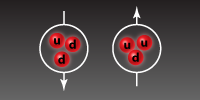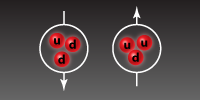Benchmarking the Standard Model
Isospin is a quantum number originally developed in the 1930s to describe the symmetry between the newly discovered neutron and the more thoroughly studied proton. Today, researchers study isospin in the context of quark physics and specifically the symmetry properties of up and down quarks. Precision experiments that look for isospin-symmetry-breaking corrections to nuclear transitions can help determine quantities like the Cabibbo-Kobayashi-Maskawa (CKM) matrix elements, which describe how the family tree of quarks is organized. They also help test the conserved vector current hypothesis, which is a fundamental tenet of the standard model and is analogous to the conservation of electric current in electromagnetic interactions. In a paper in Physical Review Letters, Dan Melconian at Texas A&M, College Station, and his colleagues report their measurement of isospin symmetry breaking in a positron-decay transition from chlorine- . Their results yield convincing support for one of the most demanding tests of the standard model: verification of the unitarity of the CKM matrix.
In their experiments, Melconian et al. measured the gamma-ray yields following positron-decay transitions from the -millisecond decay of chlorine- nuclei. Collisions of sulfur- nuclei with a hydrogen gas target generated reaction products from which the chlorine nuclei were selected. These nuclei were collected on an aluminum-Mylar tape that was rapidly shuttled to a detection station nearby. Observed gamma-ray emission from the so-called superallowed transition in the decay revealed isospin symmetry breaking that is the largest measured to date. This result was then demonstrated to be in good agreement with nuclear shell-model calculations performed by the authors, who used the same theoretical methods as those employed in the test of CKM matrix unitarity. Agreement between theory and experiment for a transition with large broken symmetry is an important validation of previous unitarity tests done with transitions having much smaller symmetry breaking. – David Voss





